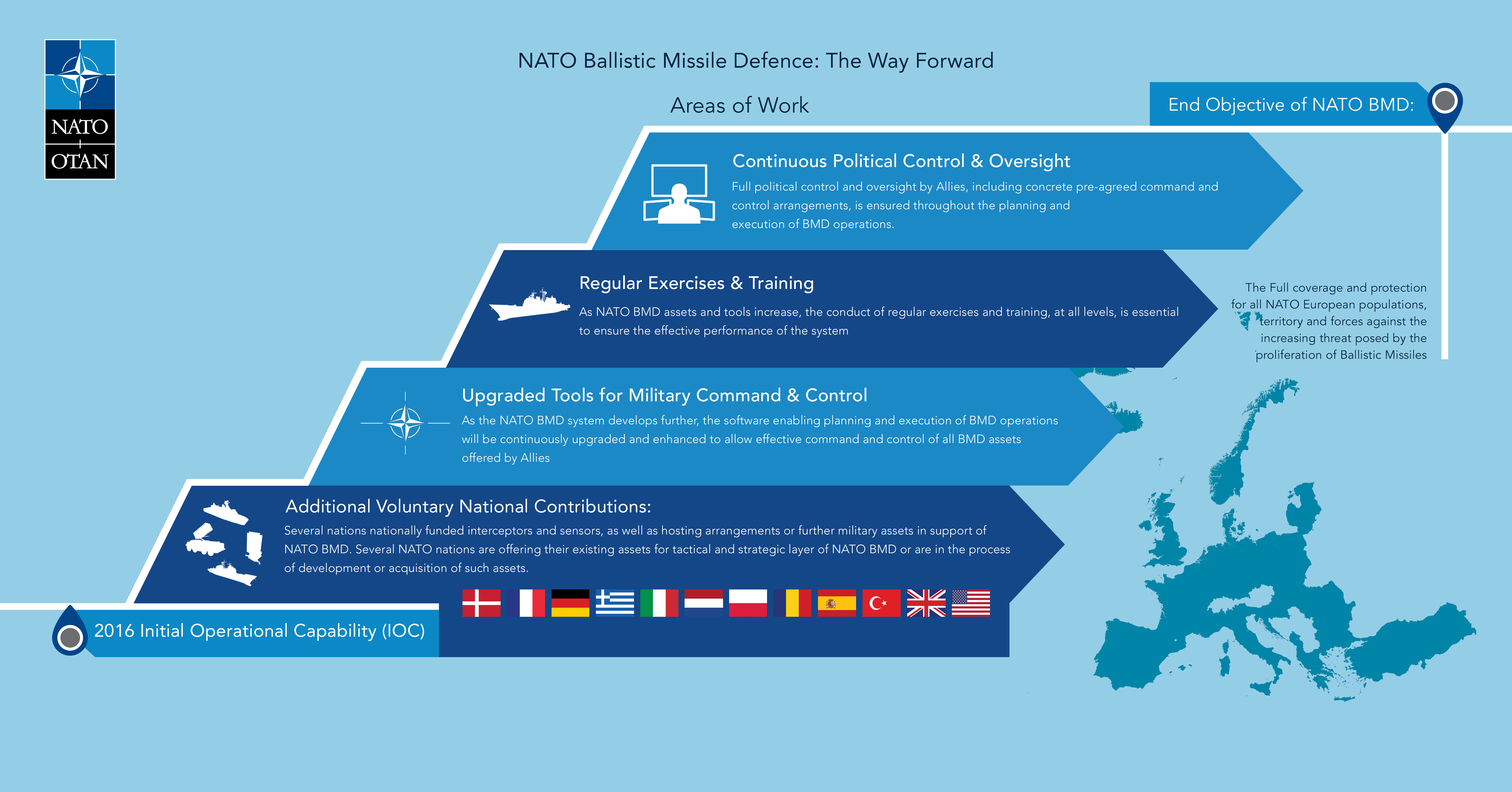Background
The North Atlantic Treaty Organization (NATO) was founded in Washington, DC in 1949. The original purpose of the Alliance was for the guaranteed protection of Europe, by the American military, against the Soviet Union during the Cold War. Since the fall of the Soviet Union and the dissolution of the Warsaw Pact, the main threat to the security of Europe is gone, but many other threats still exist.[i]
Today NATO is comprised of 30-member states, all of which are still united for the common security of each member. In 1999, NATO’s Strategic Concept recognized the need for missile defense to counter nuclear, biological, and chemical threats.
At the Prague Summit in 2002 it was agreed that a new NATO Missile Defense Feasibility Study would explore opportunities to examine options for protecting its territory, forces and population against the wide scope of emerging threats.[ii] From this came the NATO Active Layered Ballistic Missile Defense (ALTBMD) for the protection of deployed forces program to be launched in 2005.
At the Bucharest Summit in 2008, member states concluded that missile defense proliferation is an increasing threat and missile defenses are an important part of an effective response.[iii] The Alliance also considered the technical details and political and military implications of the proposed US missile defense system in Europe. Allied leaders recognized that the planned deployment of European-based US missile defense assets would help protect Allies, and agreed that this capability should be an integral part of any future NATO-wide missile defense architecture.
NATO’s 2010 Strategic Concept is the key policy document providing the framework for NATO’s activities in the area of ballistic missile defense.[iv]
The Strategic Concept recognizes, inter alia, that “the proliferation of nuclear weapons and other weapons of mass destruction and their means of delivery, threatens incalculable consequences for global stability and prosperity. During the next decade, proliferation will be most acute in some of the world’s most volatile regions.” Therefore, NATO will “develop the capability to defend our populations and territories against ballistic missile attack as a core element of our collective defense, which contributes to the indivisible security of our Alliance. We will actively seek cooperation on missile defense with Russia and other Euro-Atlantic partners.” As a defensive capability, BMD will be one element of a broader response to the threat posed by the proliferation of ballistic missiles.
On March 6th, 2013, the first European theater missile interceptor system achieved NATO interoperability with the French/Italian surface-to-air missile system. This system successfully engaged and destroyed a theater ballistic missile target in a live-fire test at the French Firing Range in Biscarrosse and proved its ability to work with NATO’s interim Ballistic Missile Defense (BMD) command and control system.
In July 2016, Allies declare Initial Operational Capability of NATO BMD, which offers a stronger capability to defend Alliance populations, territory and forces across southern NATO Europe against a potential ballistic missile attack.
2019 NATO BMD Defense Architecture and approach for the future.
There are six NATO nations – including France and Italy – that have missile defense capability and capacity beyond their national needs to support NATO, and four of them – Germany, Netherlands, Spain, and the United States have supported the missile defense mission in Turkey for NATO.

In June 2021, Secretary General Jens Stoltenberg released “NATO 2030”, a strategic agenda to guide NATO Allied and partner nation operations and goals [xi]. In light of the rapidly increasing levels of global competition and challenges to the rule-based international order, NATO 2030 detailed nine proposals to strengthen and secure the NATO alliance for the future. The nine proposals include: deeper political consultation and coordination, strengthened deterrence and defense, improved resilience, preserving NATO’s technological edge, upholding the rules-based international order, boost training and capacity building, combat and adapt to climate change, develop the Next Strategic Concept, and investment in NATO.
Current Missile Defense Capabilities Contributing to NATO BMD
| System | Operator | Number Deployed | Platform | |
| Aegis sea-based BMD | United States | Four vessels forward deployed to Rota, Spain | Four Arleigh Burke-class destroyers |  |
| Command and Control, Battle Management and Communication (C2BMC) | United States | One in Ramstein, Germany | Operations center |  |
| NATO BMD Operational Capability (BMDOC)
https://www.ncia.nato.int/what-we-do/air-missile-defence.html |
NATO | One in Ramstein, Germany | NATO Air Operations Center |
 |
| Aegis Ashore | United States | One in Deveselu, Romania | Ground-based |  |
| AN/TPY-2 Radar | United States | One in forward-based mode and deployed at Kurecik | Ground-based sensor |  |
Current Developments
The Netherlands in September 2011 announced a plan to upgrade four of its frigates with extended long-range missile defense early-warning radars that would contribute to NATO’s BMD mission.
On June 24th, 2013 it was announced that NATO signed a €136 million contract with Thales-Raytheon JV to build and deploy a ballistic missile defense system for the alliance’s air command and control system. [v] The project is expected to be completed by 2015.*
In August 2014, Denmark’s Foreign Minister Martin Lidegaard announced a plan to contribute at least one of Denmark’s Iver Huitfeldt frigates outfitted with a radar system to NATO’s BMD mission.
The United Kingdom has also announced, in November 2015, its intent to invest in a ground-based BMD radar that would enhance the coverage and effectiveness of the NATO BMD mission.
In October 2017, the United States and NATO partners wrapped up a three-and-a-half-week ballistic missile defense exercise, which included a massive collective self-defense scenario. [vi]
Less than a month later, an exercise on the Greek island of Crete demonstrated NATO’s missile defense capabilities. For two weeks, NATO air and missile defense teams tested the alliance’s ability to deter and if necessary, intercept missiles entering its airspace [vii].
Most recently, it was announced that Naval Sea Systems Command had tapped Raytheon with a contract to support the Evolved Sea Sparrow Missile (ESSM) design agent. [viii] The ESSM is a joint collaborative effort between the US Navy and 11 other NATO member nations to upgrade the RIM-7 Sea Sparrow Missile, a naval ship armament for defense against short-range anti-ship missiles.
As a result of the Russian invasion of Ukraine, NATO is working to bolster its defense of Eastern Europe through its new “air shielding” mission. The mission brings together NATO countries’ missile and air defense units under NATO leadership to “provide a near-seamless shield from the Baltic to the Black Sea, ensuring NATO allies are better able to safeguard and protect alliance territory, populations and forces.” The U.S., Germany, and the Netherlands have set up Patriot systems in Slovakia and Poland; France moved its “Mamba” surface-to-air missile defense system to Romania; and Spain is using its National Advanced Surface-to-Air Missile System (NASAMS) in Latvia [ix].
October 13, 2022, 14 NATO member states and Finland signed a letter of intent to develop the European Sky Shield Initiative (ESSI), led by Germany [x]. The 14 member states were: Belgium, Bulgaria, Czechia, Estonia, Germany, Hungary, Latvia, Lithuania, the Netherlands, Norway, Slovakia, Slovenia, Romania, and the United Kingdom. ESSI was created to promote common air and missile defense procurements and deployments throughout NATO Allies and partners to expand the defense of Europe and lower costs for all those involved.
Recent News
- Dutch troops take over former US-led NATO air defense mission in Poland
- NATO official: Cloud-based data sharing must replace legacy systems for counter-drone ops
- NATO fighters scrambled, air defenses alerted amid deadly Russian strikes in Ukraine
- Netherlands to Explore Local Production of US-Made AMRAAM Missiles
References
[ii] https://www.nato.int/docu/comm/2002/0211-prague/index.htm
[iii] https://www.nato.int/cps/en/natolive/official_texts_8443.htm
[iv] https://www.nato.int/strategic-concept/pdf/Strat_Concept_web_en.pdf
[v] http://www.aofs.org/2013/06/20/nato-contract-to-integrate-theater-ballistic-missile-defense-command-and-control-capability/
[vi] https://news.usni.org/2017/10/16/navy-nato-forces-conduct-integrated-air-missile-defense-exercise-off-scotland
[vii] https://www.stripes.com/news/crete-exercise-tests-nato-s-missile-defense-capabilities-1.496607
[viii] https://www.upi.com/Raytheon-to-support-Evolved-Sea-Sparrow-Missile-for-US-NATO-partners/8291515084757/
[ix] https://www.airforcetimes.com/flashpoints/2022/08/02/nato-fortifies-eastern-europes-defenses-under-new-air-shielding-mission/
[x] NATO – News: 14 NATO Allies and Finland agree to boost European air defence capabilities, 13-Oct.-2022
